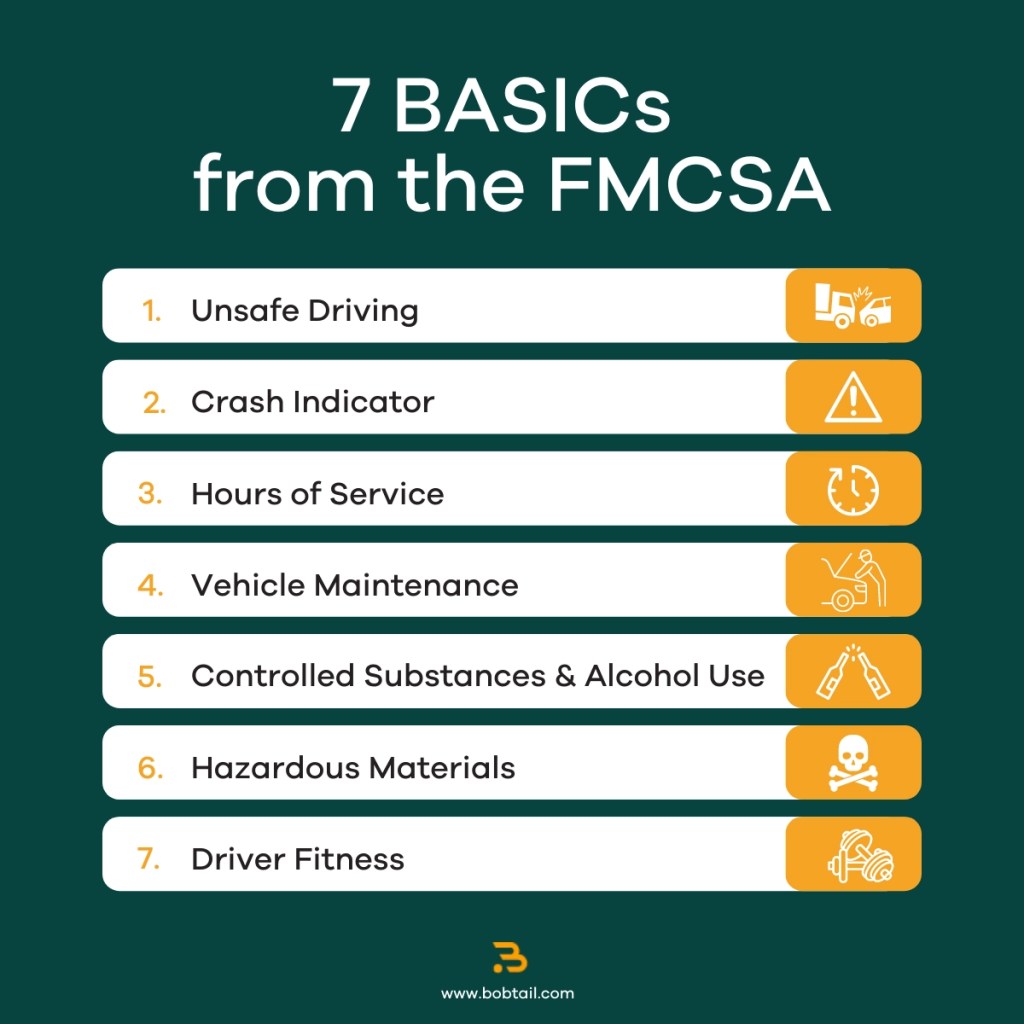A few years ago, a first-time fleet owner was working through the details of his New Entrant Safety Audit. He asked the officer in charge why the process was so involved.
“You’ve got an 80,000-pound missile going down the road,” the officer told the fleet owner. “We have to make sure you get this right.”
That’s compliance in a nutshell: occasionally grueling, perhaps, but purpose-built to improve safety. Freight transportation regularly lands in top-five lists of industries with the most workplace injuries. Between 2020 and 2021, workplace fatalities for truckers and other driving trades rose by 16.3%, surpassing 1,000 deaths the latter year.
In other words, driving a semi truck can be dangerous. Regulatory agencies try to reduce those risks. Of course, the law goes beyond protecting human health. There are legal and financial considerations baked into trucking compliance, too.
Given these worthy goals, it’s a mistake to dismiss compliance as a meaningless intrusion. Besides, remaining compliant isn’t so tough once you know what to do. So how exactly do you comply with trucking rules? Start by reading this introduction to compliance for trucking companies.
Nothing that follows is legal advice, and it’s not comprehensive. For detailed guidance, seek an expert in transportation law.
Trucking Compliance: The BASICs
Where there’s compliance, there are rules. When we talk about compliance for trucking companies, we’re talking about certain federal regulations.
Specifically, you must meet the requirements of the Code of Federal Regulations Title 49, Subtitle B, Chapter III—with the bulk of your obligations as a carrier located in Subchapter B, Parts 350 through 399.
Don’t worry, though. You don’t need a law degree to master trucking compliance. These regulations are enforced by a division of the United States Department of Transportation (DOT) called the Federal Motor Carrier Safety Administration (FMCSA), which can help you stay compliant.
“If a trucker says, ‘How do I maintain compliance?’ what they mean is: ‘How do I make sure that I’m meeting the expectations of the Federal Motor Carrier Safety Administration?’” says an experienced fleet owner.
The FMCSA works with trucking company owners to develop safety strategies and ensure compliance with DOT regulations. That starts with registering your trucking company. You do that by obtaining a USDOT number and operating authority (also called a motor carrier, or MC, number). Learn how to complete these registrations here.
Within the first 12 months of your operation, the FMCSA will conduct the New Entrant Safety Audit we mentioned above. Here’s our advice on that process, and here’s the FMCSA’s guidebook.
After that, compliance becomes a daily task. The FMCSA tracks every carrier’s safety record through its Compliance, Safety, and Accountability (CSA) program, which organizes safety compliance into seven categories:

- Unsafe Driving
- Crash Indicator
- Hours of Service
- Vehicle Maintenance
- Controlled Substances and Alcohol Use
- Hazardous Materials
- Driver Fitness
The FMCSA calls these areas of study Behavior Analysis and Safety Improvement Categories, or BASICs, and tracks them through the digital Safety Measurement System (SMS). Our first tip is to log into your SMS account regularly. Your SMS data will warn you if you’re slipping into noncompliance.
In the interest of avoiding that fate, here’s an overview of compliance with FMCSA rules for each of the seven BASICs:
1. Unsafe Driving
To comply with FMCSA driving rules, truck drivers must follow all the local traffic laws—but that’s just the beginning. The legal basis of the Unsafe Driving BASIC can be found in 49 CFR Part 392, which provides all the specific requirements. That includes prohibitions on driving in possession or under the influence of drugs or alcohol, as well as general rules against unsafe driving. (If you handle hazardous materials, this BASIC also includes 49 CFR Part 397.)
If you’re an owner-operator, you choose how to drive. Avoid speeding, reckless lane changes, and lapses of attention. If you employ truck drivers, your job is to educate every employee on the relevant regulations. Regular safety training can help reduce the risk of noncompliance with driving rules.
Learn more about the Unsafe Driving BASIC in this FMCSA Factsheet.
2. Crash Indicator
The FMCSA compiles records on truck accidents as reported by state law enforcement. The agency fits crash reports into an overall safety score through the Crash Indicator BASIC. Other than ensuring all your drivers operate safely, there’s not a lot you can do to avoid accidents—but compliance with these rules also requires some record-keeping.
Trucking company owners must:
- Maintain an up-to-date Accident Register form
- Keep copies of police accident reports and related records
- Submit an updated MCS-150 form every other year
Trucking companies are required to update the MCS-150 form every two years. Among other things, this document informs the FMCSA of your company’s total cumulative mileage. That figure is part of the SMS calculation that “scores” your Crash Indicator BASIC, which is why we’re discussing it here.
Learn more about the Crash Indicator BASIC in this FMCSA Factsheet.
3. Hours of Service
As you probably know, trucks must be outfitted with an electronic logging device (ELD) to track on-duty hours. This category is where the FMCSA uses all the data your ELD captures. Drivers will run afoul of FMCSA regulations if they drive longer than allowed or if they falsify hours-of-service data.
Hours-of-service regulations are subject to change. Find the latest regulations here.
Learn more about the Hours of Service BASIC in this FMCSA Factsheet.
4. Vehicle Maintenance
The most important thing you or your drivers can do to comply with vehicle maintenance rules is to always complete your pre- and post-trip inspections. Log the results of these inspections and hang onto those records.
You’ll also need to complete all preventative maintenance recommended by equipment manufacturers. You need annual vehicle inspections, too. Keep hold of all these records, along with receipts for repairs and evidence that you or your drivers are well-trained in securing loads safely.
For a detailed list of rules about vehicle maintenance, see 49 CFR Parts 392, 393, and 396.
Learn more about the Vehicle Maintenance BASIC in this FMCSA Factsheet.
5. Controlled Substances and Alcohol Use
It’s not enough for drivers to avoid drugs and alcohol. You also have to prove that they’re doing so. The FMCSA requires every carrier to register with their Drug and Alcohol Clearinghouse, which keeps data on all recorded drug and alcohol tests.
Find specific requirements in 49 CFR Part 382, which requires drug-and-alcohol testing for new drivers, after accidents, and at random intervals throughout employment. Learn how to register with the FMCSA Drug and Alcohol Clearinghouse here.
Learn more about the Controlled Substances and Alcohol Use BASIC in this FMCSA Factsheet.
6. Hazardous Materials
If you don’t transport hazardous materials, feel free to skip this section. But if you do, you have a whole new universe of compliance to understand. The laws that feed into FMCSA rules about haz-mat include:
- 49 CFR Part 397
- 49 CFR Part 171
- 49 CFR Part 172
- 49 CFR Part 173
- 49 CFR Part 177
- 49 CFR Part 178
- 49 CFR Part 179
- 49 CFR Part 180
Among other requirements, these laws compel carriers to label trailers and containers properly. They require you to safely secure haz-mat packages. They also restrict how you load and unload these materials, and how you handle leaks.
Learn more about the Hazardous Materials BASIC in the FMCSA’s Factsheet.
7. Driver Fitness
The FMCSA requires drivers to be both trained and healthy enough to safely operate a commercial vehicle. They enforce that law through the Driver Fitness BASIC, which is legally enforceable through 49 CFR Parts 383 and 391.
To comply with driver fitness rules, make sure your drivers (or you, if you’re an owner operator) have appropriate CDLs. You also need to maintain a Driver Qualification File, which must include at least:
- The driver’s employment application
- CDLs and road test certificates
- The driver’s three-year employment history
- Safety performance history data
- Drug and alcohol test results
- A medical examiner’s certificate
Learn more about building and maintaining Driver Qualification Files here, and find the Driver Fitness BASIC Factsheet here.
Freeing Time for Trucking Compliance Paperwork
As the first-time fleet owner we spoke to discovered, compliance involves a lot of paperwork. That can distract from essential business operations like invoicing and collections. Bobtail’s factoring service can help with these back-office tasks—and reduce your time-to-payment from weeks to just hours.
When you factor with Bobtail, we pay your invoices now, then collect from your customers when the bill comes due. Not only does that ensure consistent cash flow for your business, it takes collections duties off your plate. And when you don’t have to worry about cash flow or collections, you can spend more time keeping up with trucking compliance.
Ready to try the simplest way to factor trucking invoices? Contact Bobtail today.

Article By
Keep Learning







